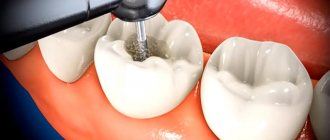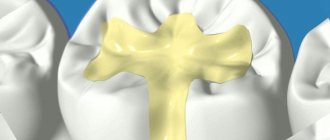How are dental implants done today?
Almost all patients who decide to undergo this operation are concerned about the question of how dental implantation works. The procedure involves the following steps.
- An implant is placed in the prepared hole, then it is covered with a gum flap, sutured and wait until it integrates. Healing of the implant takes several months: about two or three - on the lower jaw, from four to five - on the upper jaw.
- A small circular incision is made in the gum and a gum former or abutment is installed on the implant and loaded with a temporary crown.
- Impressions are taken, a permanent crown is made and installed on the implant.
Immediately installing a permanent crown is not recommended, as it puts strong pressure on the implant, which leads to its rejection. The two-stage technique is ideal for smokers and patients who do not take good care of hygiene - bacteria will not be able to penetrate into the closed socket, and the risk of implant rejection will be minimized.
The two-stage method is most often used to restore already missing or traumatically removed teeth, when there is not enough bone tissue in the area where the implant is installed. In these common situations, bone volume needs to be increased. Sometimes this manipulation can be carried out simultaneously with the installation of the implant, but most often it is necessary to postpone the implantation for several months and wait until the required volume of bone tissue is formed.
The process of installing a dental implant before and after
Stages of implant installation and timing
The implantation procedure can be one-stage or two-stage. With a one-step procedure, all steps can be completed in one day, which is why it is sometimes called express implantation. But it still takes several months for the implant to fully heal, during which you cannot put full load on the artificial tooth. Another feature of one-stage implantation is the installation of a one-piece structure (implant + abutment), so if necessary, replacing it will present a certain difficulty.
Two-stage implantation includes the installation of an implant, and after a certain period (3-6 months) a permanent crown is placed on it. This requires several visits to the dentist, but in many cases this process is more justifiable for medical reasons. It is less risky and allows for more careful monitoring of the condition of the oral cavity at all stages of treatment.
The installation stages and timing of dental implantation depend on the specific situation, the anatomy and physiology of the patient, his financial capabilities, as well as the treatment plan chosen by the doctor.
It is also necessary to understand that in addition to the implantation procedure itself, diagnostics are also required (X-rays and tomograms, blood tests), treatment of caries on all teeth, removal of teeth that cannot be restored, taking impressions and making crowns, and in some cases, bone grafting. All this also takes time and sometimes significant time.
Preparation for implantation: diagnostics and modeling
Before implantation, you must visit the doctor at least 2 times. The initial consultation allows the implantologist to examine the oral cavity, get acquainted with the patient’s wishes, assess the prospects for treatment, and also take the necessary x-rays and tomography showing the condition of the jaw bone tissue and the presence of externally invisible features and pathologies of the dentition.
After this, the doctor prescribes:
- laboratory tests (tests),
- consultations with related specialists (at least an orthopedist and anesthesiologist, and in the presence of chronic diseases - specialized doctors: a cardiologist, an endocrinologist),
- sanitation of the oral cavity (treatment of caries and other diseases, professional cleaning, as well as removal of teeth that cannot be treated),
- correction of existing dentures and crowns,
- if necessary, bone grafting.
After completing all the established measures and removing obstacles to implantation, the doctor checks the condition of the oral cavity and sets a date for the operation, concludes an agreement, and talks about how to prepare for the operation.
Installing implants is only half the battle. After this, it will be necessary to install crowns on them. To do this, the patient's jaw is modeled. Photometry is performed - photographs of the face are taken in different positions, the facial arches are studied, then the characteristics of the bite are studied, and the work of the temporomandibular joint is examined. After this, a 3D model of the jaw is created, on which the doctor plans the installation.
Surgery: installation of implant and healing abutment
How long does it take to install an implant? The operation itself can be performed in different ways, depending on the choice of method, type of material, and other reasons. If we talk about the most common case of two-stage endosseous implantation, it is carried out as follows: the doctor makes incisions in the gum, drills a hole in the jawbone and installs a root-shaped screw implant, after which the gum is sutured around the implant, completely covering it. After a few days, the doctor removes the stitches. After 3-6 months, the gum is opened and a gum former is placed on the implant, and after another 2-3 weeks - an abutment and crown.
Incisions can be made not with a scalpel, but with a laser - it is believed that this is less painful (the dose of anesthetic can be reduced), produces less bleeding, and there is no need for stitches after laser implantation. But this method significantly increases the cost of implantation (by 30-60%).
Orthopedics: prosthetics on implants
This is the final stage of dental restoration using implantation, which reproduces the functionality and aesthetics of the dentition. Orthopedic structures of 3 types can be installed on implants: a single crown, simulating one missing tooth, a bridge prosthesis, replacing several lost teeth in a row, and a complete prosthesis, simulating the entire dentition.
According to the stage at which orthopedic structures are installed that transfer the load to the implant, there are:
- implantation with immediate loading - the crown is placed immediately, immediately after the operation, or within 72 hours after it, this is the fastest method, but the risk of material rejection is maximum here,
- implantation with early loading - the crown is placed within 4-6 weeks after implantation, with a temporary crown usually placed, which is replaced with a permanent one a few months later,
- implantation with late loading is the most traditional method, in which the risk of rejection is minimal, since the chewing load, which can damage the fusion of the implant with the bone tissue, is transferred to the tooth after the material has engrafted.
With two-stage implantation with late loading, the risks are minimized, since the implant rests for several months without chewing load, and the likelihood of infection is also minimal due to the fact that the implant support area is hidden under the gum.
When making prosthetics, it is imperative to take into account the compatibility of materials in order to eliminate the possibility of breakage of the prosthesis, as well as to hide the possible transmission of the supporting structure through the translucent material of the crown.
What are the latest dental implant technologies?
One-stage
Today, an implant can be installed in just one day. This modern technology is called one-stage implantation. Do not confuse it with one-stage, these are two fundamentally different methods. Single-stage implantation is carried out immediately after tooth extraction, and during a one-stage procedure, a temporary crown or gum former is installed simultaneously with the implant. The one-stage method is most often used when restoring the frontal group of teeth, so that the patient does not feel embarrassed about his smile. In addition, installing a temporary crown or former at the same time as the implant helps to correct the shape of the gums, which plays an important role in creating an ideal smile.
Together with tooth extraction
Single-stage dental implantation - how does it happen? Such an operation can be carried out only under ideal conditions: if the tooth was removed atraumatically, there are no inflamed hard and soft tissues left in the socket, and there is sufficient bone tissue present. If the conditions are unsatisfactory, bone material is poured into the hole, and after a couple of months, two- or one-stage implantation is performed. Moreover, in some cases, a one-step technique can become a one-stage one. For example, if the implant is installed into the bone with a certain force, and there is no severe inflammation in the patient’s oral cavity.
By template
New technologies for dental implantation, such as surgery using a surgical template, make it possible to correctly position implants in the oral cavity. Before the procedure begins, a special template is made for the patient, which is sent to the computed tomography department, where the template is scanned, and then the patient along with it. Next, the computer models are combined in a special program. The resulting stencil allows you to first work with aesthetics, that is, determine where the crowns or dentures will be placed, and only then place implants under them. This unique technology helps to achieve an excellent visual effect, accurately install implants even in areas with the minimum allowable bone volume, without affecting vessels and other anatomical formations, and also reduce the procedure time. Using a surgical template before dental implants is ideal for patients who are missing all or several teeth in a row.
When it is possible to perform implantation - the doctor chooses after a complete diagnosis
It is necessary to study the condition of the bone tissue, its size and density. Based on the results, the doctor makes a decision - delayed or immediate implantation. Our Center is equipped with diagnostic equipment, so results can be obtained within 15 minutes . But this is only a preliminary assessment; the final decision is made after tooth extraction.
Levin Dmitry Valerievich
Chief physician, Ph.D.
How does implantation proceed from start to finish?
Let’s simulate a situation where the patient has previously undergone an examination and comes to the clinic directly for implantation. How does dental implantation proceed in this case? First, he is given anesthesia, local and not general. Even the longest operation does not take more than two hours and does not require such a serious type of anesthesia as anesthesia for dental implantation. Further, the procedure regulations depend on the type of implantation: if we are talking about a two-stage technique, then first the gum is cut, a hole is made in the bone, an implant is installed in it, which is covered with a flap, and then suturing is done. All of the above manipulations take no more than fifteen minutes. If the operation follows a template, then the installation of each implant takes no more than ten minutes, since no cutting of the gums or suturing is required.
Single-stage and one-stage implantations last a little longer, since they require either tooth extraction or the installation of a crown or gum former.
Technology for installing dental implants in pictures
Implants should be installed in a sanitized oral cavity, so visiting a therapist and hygienist will not be a bad idea. Consulting doctors are also competent in how dental implantation proceeds; they will treat caries and remove all dental plaque, thereby minimizing the risk of implant rejection.
Does it hurt during implantation?
All procedures are carried out under local anesthesia, so the patient does not experience any painful sensations - he only feels the mechanical work of the doctor in the mouth, as during conventional dental treatment. In fact, the manipulations performed when installing an artificial root are less invasive and traumatic than when removing a tooth.
If you are very worried and are terrified of the upcoming operation, the clinic may offer implantation under sedation - in a relaxed state, but in full consciousness. The patient is given drugs that put him into a light sleep and he ceases to experience anxiety.
How many implants are needed and which ones to choose?
Installing ten implants on each jaw is an ideal solution for patients suffering from complete edentia. However, a good result can be achieved with eight or even six implants. More economical options are removable dentures on four implants. The most budget-friendly alternative is a removable denture on two implants. Some patients believe that two or four implants will not be able to withstand the load placed on them during jaw work and will be rejected. In fact, the pressure during chewing is distributed throughout the entire prosthesis and falls not only on the implants, but also on the bone and gum, so there is no need to fear rejection.
The choice of product depends, firstly, on the volume of bone tissue. If there is a lot of bone, then any implant can be installed, and if not, then only a certain size. Secondly, from the methodology. Thus, it is possible to carry out one-stage implantation only if the implant is tightly fixed in the bone. To do this, either its rod or thread must be of large diameter. Not all companies produce such aggressive implants, so the patient has not much choice. And thirdly, from the budget.
Answers to popular questions
Is it possible to install implants for diabetes?
Controlled diabetes mellitus is not a contraindication to dental implantation. Based on the results of the analysis for glycated hemoglobin, patients are divided into three groups:
- less than 6% - dental implants can be placed without any restrictions;
- from 6% to 8% - implantation is possible, but with minimal risk (special preparation is required);
- more than 8% - surgery is possible only after the patient reduces the level of glycated hemoglobin to the required levels.
The Family Dentistry clinic successfully performs dental implantation for diabetes mellitus according to an individual treatment plan, taking into account the specific clinical picture. We try to use technologies that allow us to avoid bone grafting - the operation is less invasive (traumatic), and healing is easier. In addition, we install Straumann implants with the hydrophilic surface SLActive, which eliminates blood supply disturbances in diabetes and promotes successful osseointegration in bone tissue.
Is it possible to place implants with periodontitis or periodontal disease?
Yes, you can. But treatment is required first, incl. Possibly gum and bone grafting.
With periodontitis, bone tissue atrophies, so osteoplasty may be required at the time of implantation of a titanium rod into the jawbone. Some clinical situations allow you to install an implant immediately after gum surgery for periodontitis, while others require up to 6 months for the bone material to engraft.
In patients with periodontitis, the gums are less dense and decrease in width and height. This is dangerous because a pocket may form between the neck of the implant and the gum, in which bacteria will accumulate. As a result, there is a high risk of titanium screw failure. That is why the dental surgeon first performs gum surgery.
What anesthesia is used to place dental implants?
Local anesthesia is most often used. It is enough so that the patient does not experience any pain when installing implants. A combination of local anesthesia with sedation (a state of drug-induced semi-sleep) helps to cope with the experience.
It is important to understand that the jawbone is not innervated. Therefore, it is necessary to numb only the mucous membrane, which local anesthesia copes well with.
Why does an implant take root faster when installed in the lower jaw than in the upper jaw?
Yes, titanium rods implanted in the lower jaw take root within 2-4 months, and in the upper jaw - from 3 to 6. This is due to the fact that the mandibular bone tissue is more dense.
What are the dangers of smoking after implantation?
Until about 10 years ago, smoking was an absolute contraindication to the installation of implants, and many dental clinics simply refused such patients who were at risk.
Nowadays, even heavy smokers are implanted, but smoking remains the worst enemy of dental implants. It promotes the growth of bacteria in the mouth and accelerates the formation of plaque. It also leads to irritation of the mucous membrane and constriction of blood vessels, slowing down the healing process of tissues after surgery. Thus, smoking not only significantly slows down the process of engraftment of artificial roots, but also increases the risk of their rejection.
Can I drink alcohol after getting dental implants?
It is advisable to avoid alcoholic beverages not only while taking antibiotics after implantation, but also for the entire period of osseointegration (i.e., 3-6 months) for the following reasons:
- irritates the mucous membrane, slowing down the process of engraftment of the titanium rod;
- dilates blood vessels, causing bleeding at the site of implantation of the artificial root;
- increases the risk of developing hematoma.
Still have questions about installing implants? Get a free consultation with an implantologist.
| Expert, author of the article: Akhtanin Alexander Pavlovich Orthopedic dentist, implantologist 35 years of implantation experience Material updated: October 11, 2022 |
Do I need to follow certain rules after surgery?
After the procedure, you must follow all the specialist’s recommendations. In the first two to three days, you should not rinse your mouth in the area of the implant, since blood cells that promote its healing are washed out from the operated area. However, it is still necessary to clean the implant installation area, although very carefully. To do this, you can use special brushes with soft bristles and a paste with an antiseptic effect. For three to four days after the operation, you should not exercise, carry weights, or visit a sauna, bathhouse or solarium. And - most importantly - if any unpleasant or abnormal sensations occur, you must immediately contact your dentist. If you carefully care for the implant and follow all recommendations, it will last you a lifetime.
Life time
Initially unlimited. This means titanium rods can last a lifetime. Only the crown will be subject to periodic replacement. In order to reduce the cost, manufacturers come up with various materials in both directions: increasing, as well as decreasing, quality and cost.
The accuracy of the work done is an additional factor affecting the life of the pin. The distribution of chewing load, position in space, bite, normal jaw pressure and other factors that directly affect the service life depend on the correctness of the calculations.
Which option to choose depends on financial capabilities and specific recommendations of the doctor. You should always remember that the durability of any product depends on its care. If you take good care of the implant, following all the dentist’s recommendations, the pin will last a long time.
An implicit but important parameter influencing this indicator is cost. High-quality materials will cost more. However, strong components at the heart of such products are the key to long-term use and a quiet life.
The article discussed in detail the question: how a dental implant is inserted and screwed in, indications for having it implanted, types of operations with detailed explanations of their stages.
Who can undergo implantation and who cannot?
Implants cannot be installed in girls under eighteen years of age, and in boys under twenty-one years of age, since during this period the bone is still forming, and implantation can disrupt this complex process. As for the upper age limit, there is no upper age limit for installing implants. Absolute contraindications include disorders of blood clotting and bone regeneration. It is prohibited to perform the operation on pregnant women and people with an unbalanced psyche. In all other cases, implantation is possible.
Stage four: gum formation
Duration - 1 week
This stage is relevant only for the classical implantation method, in which implants, after installation, take root within several months, covered with gums. 1-2 months after implantation, the gums open and a special device is fixed on the implant - the gum former. It is necessary to adjust the gingival contour so that after installing dentures, the gums in the area of the artificial tooth are smooth, beautiful and uniform throughout the entire dentition. In some cases, plastic surgery may be required, which involves surgically adjusting the position of the gums.
What is the cost of dental implants?
The process of dental implantation is quite complex, with many subtleties and nuances. Therefore, its price is appropriate. In dentistry, the minimum cost of a South Korean implant and its installation is 18,000 rubles. It comes with a five-year warranty, but with adequate care it will last you a lifetime. German implants are more expensive - from 30,000 rubles, but they have a lifetime guarantee. The cost of implants for a one-step technique is 36,000 rubles. The price list of premium level products starts from 42,000 rubles. Additional manipulations, such as bone grafting, are paid separately. Bone tissue augmentation costs from 18,000 rubles to 40,000 rubles, depending on the complexity of the operation. The cost of a temporary crown is 12,000 rubles, a permanent one - from 18,000 to 34,000 rubles. Dentures on implants cost from 64,000 to 190,000 rubles.
Alternative options for tooth restoration after extraction
After removal, doctors recommend restoring the tooth in a short time. This is caused by bone tissue atrophy, which begins in the absence of chewing load, which complicates recovery in the future.
If for some reason the patient is not ready for implantation, alternatives can be offered:
- Bridge prosthesis. It is a non-removable structure of interconnected crowns. For installation, two supporting teeth are depulped (nerve removal, canal filling) and ground down for crowns. At the same time, the load on the support increases, mobility develops, which is why the bridge will need to be replaced. The bridge structure is not able to completely prevent bone tissue atrophy, but it prevents rarefaction, displacement, and curvature of the dentition. The rate of bone atrophy and the development of mobility depend on the patient’s health.
- Removable dentures . They represent a structure made of artificial gum with soldered crowns, attached to adjacent teeth with hooks. The supporting teeth are ground down if the fastenings are metal. The prosthesis has a range of mobility and requires careful care, since food particles can get under it. Removable dentures do not stop atrophy, but they do prevent displacement of adjacent units.
Implantation prevents all problems, including bone atrophy. An implant is an artificial root on which a crown is placed. Neighboring teeth are not ground down or damaged. The chewing load is maintained. The survival rate of dental implants is 98%. Implantation is considered the most reliable way to prevent bone resorption.
Types of implants
Fixed implantable prostheses can be intraosseous or extraosseous.
Intraosseous
If you look at the implant carefully, like an orthodontist, you can distinguish not 2, but 3 parts:
- supporting;
- transgingival;
- the largest is intraosseous.
The intraosseous shape of implants is different, repeating or not repeating the shape of the tooth root. It is by these criteria that the types of dental implants are most often classified.
The shape of the intraosseous part of the prosthesis is usually made in the likeness of a tooth root. Then healing after implantation will be quick, and the chewing load will be distributed evenly in the jaw.
Lamellar
The surface of these implants is textured and (or) corrugated. There is also a macro-relief resembling a snake. To allow bone tissue to grow through the prosthesis after implantation, holes are provided in the structure. Their total area does not exceed a third of the area of the intraosseous part.
There are:
- non-separable;
- collapsible, with internal or external thread for installing the head.
Root-like
Root-shaped (endosseous) implants include:
- cylindrical. The intraosseous part is smooth, with a small surface area. It is characterized by the lowest biomechanical performance in the shear test, so the cylindrical part is made textured (bioactive coating). They are produced only collapsible;
- screw. With different thread profiles, detachable and one-piece. The surface can be smooth or rough;
- basal. Longer, with a thread at the end to secure itself in the deep layers of bone.
Mini-implants that are installed for a limited time are also classified as root-shaped. This is not to say that they are thinner or shorter than regular ones. They have a simplified and slightly lighter design for people with osteogenesis disorders.
If the root-shaped implants are not connected to each other, their rotation can occur even after a period of bone tissue regeneration. The most common causes are medical manipulation and chewing load. Therefore, their design includes anti-rotation locks (anchors, holes, longitudinal grooves, etc.).
Types of root-shaped implants
Combined
The intraosseous part of the implant can also be a combination of cylindrical and plate-shaped:
- the central part is a cylinder;
- “lateral roots” - 2 asymmetrically or symmetrically located plates.
This type also includes disc, transmandibular (designed with a bracket and 2 pins) implants. Implants of a combined form are usually detachable.
Extraosseous
For osteoporosis or osteonecrosis of the jaw, extraosseous implants are sometimes used for patients in the older age group.
Subperiosteal
These prostheses are used for the rehabilitation of patients with significant atrophy of the jaw bone tissue. They are screwed into the periosteum on the side of the gum.
Intramucosal
They are used when there is a lack of bone tissue, when the patient refuses augmentation, sometimes as a temporary measure. A small, mushroom-shaped magnet is inserted into the gum. In the future, it serves as the basis for removable orthodontic structures.
Stabilization
When implanted, the prosthesis is mounted on the natural root of the tooth, takes root well, but is considered temporary, since the “base” dries out with age, like any bone tissue.
Preparatory stage of implantation
The preparatory stage before implantation is carried out for two purposes: to choose the most suitable type of treatment and to check the possibility of carrying out the procedure in principle. At this step, diagnostic procedures are performed:
Based on the results of objective examinations and instrumental examination data, a decision is made on the need for additional preliminary procedures. What could it be:
- treatment of caries, pulpitis (implantation is a serious intervention, and any inflammation can aggravate its implementation);
- removal of adjacent teeth;
- osteoplasty (compensation for bone deficiency, carried out using sinus lifting, bone grafting or directed regeneration).
Indications for implantation
Dental implants are installed when the formation of the skeleton is complete and bone growth has stopped. The upper age limit is individual. In orthodontics, there are cases where implantation was carried out for people 70-85 years old. If the patient is relatively healthy, the implant can be installed.
Implantation is indicated if:
- one tooth is missing, and next to it all are healthy (intact) or with limited defects;
- 3 or more teeth are missing in a row, up to complete absence;
- there is an allergic reaction to plastic;
- the patient has illnesses or psychological reasons due to which he cannot wear a removable denture.











